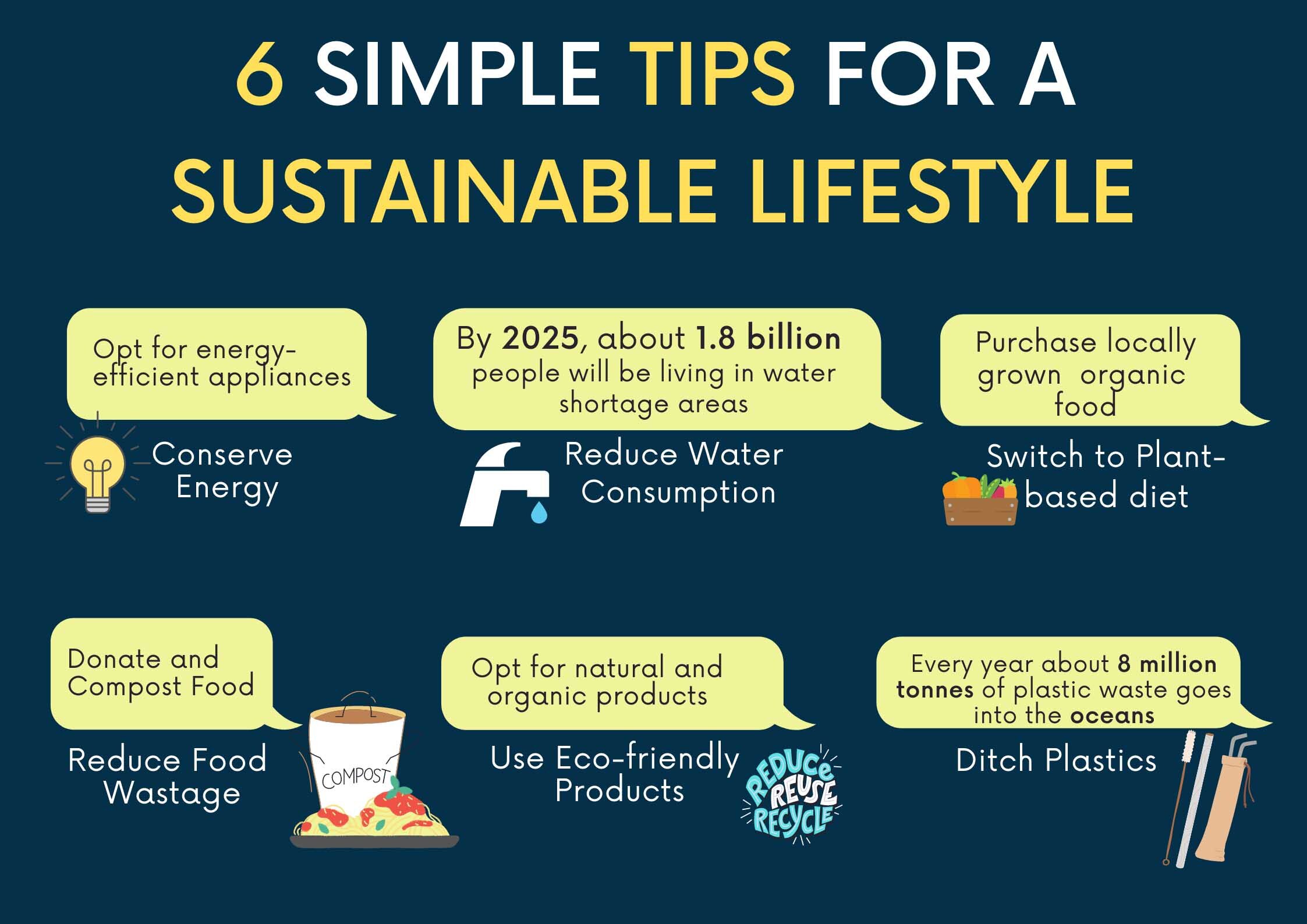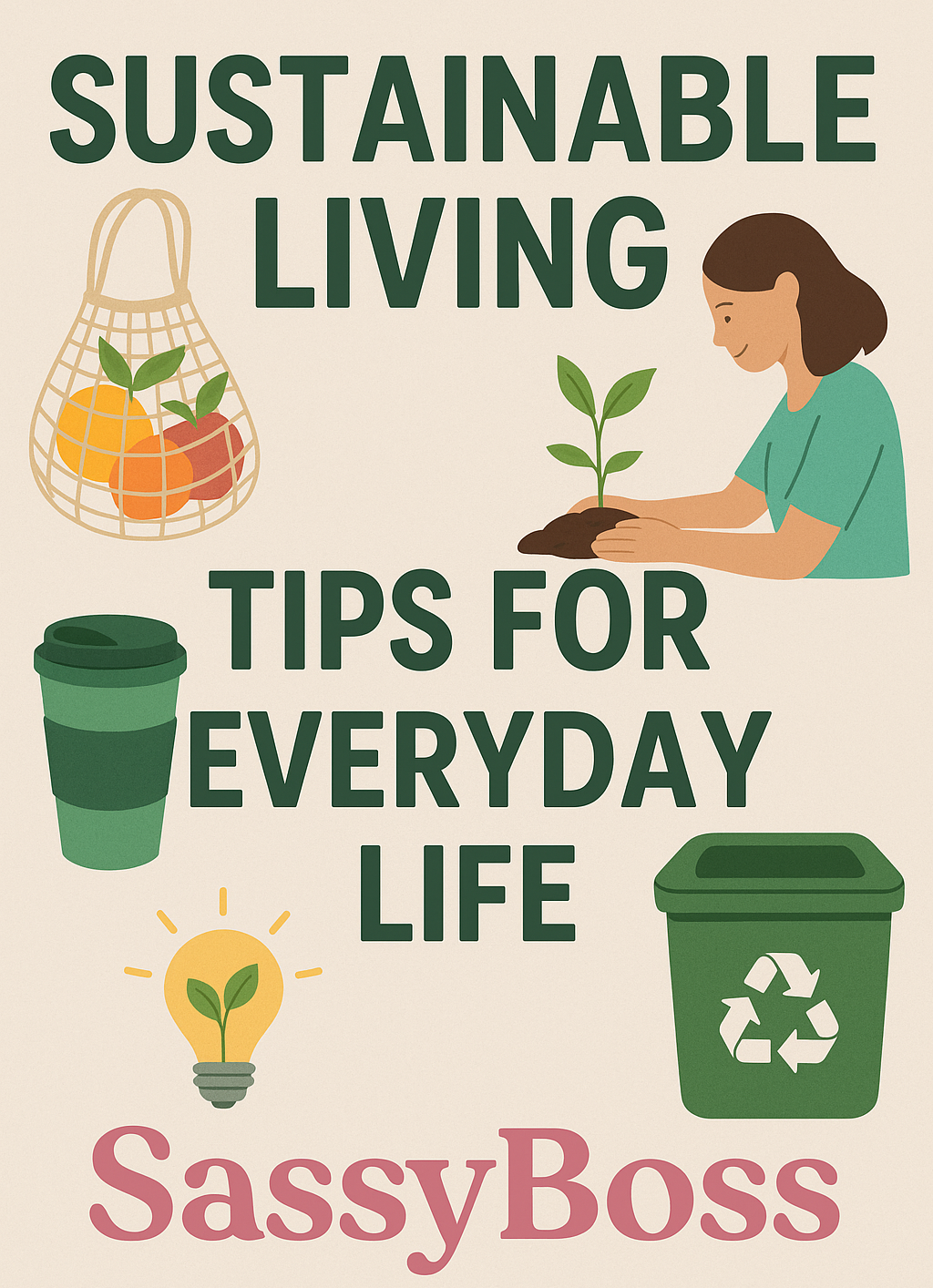Sustainable Living Tips for Everyday Life
Sustainability has evolved from a specialized issue to a worldwide one in recent years. As the earth faces threats from climate change, resource depletion, and environmental degradation, more people are looking for methods to live more sustainably. The good news is that leading a sustainable lifestyle doesn’t necessitate significant adjustments or long-term dedication. Your quality of life and the environment can both be significantly improved by taking little, deliberate actions in daily life. We’ll look at a number of doable, simple sustainable living strategies below that anyone may use.

1. Reduce, Reuse, Recycle
Reducing, reusing, and recycling—the traditional “3 Rs” of sustainability—remain some of the best ways to cut waste. The following is how to use them:
– Reduce:
This includes initially consuming less. Consider whether you really need the things before making impulsive purchases. You can decrease the amount of trash produced during production, transportation, and disposal by lowering consumption. When it comes to apparel, technology, and other products, choose quality over quantity because long-lasting items typically have a smaller environmental impact over time.
– Reuse:
The need for new products can be decreased by reusing or repurposing existing items. Consider whether something can be utilized for something else before discarding it. For instance, old t-shirts can be turned into cleaning cloths and glass jars can be utilized for storage.
– Recycle:
Recycling is a crucial part of trash management, but it works best when done correctly. Make sure you understand the recycling regulations in your area because some places only take specific kinds of items. Additionally, to lessen the quantity of garbage that ends up in landfills, attempt to purchase goods with recyclable packaging.
2. opts for Energy Efficiency
Energy use is one of the main causes of environmental damage. Here are some strategies to cut down on energy consumption and your carbon footprint:
– Switch to LED bulbs:
Compared to conventional incandescent bulbs, LED bulbs consume significantly less energy and have a longer lifespan. Even while their initial cost may be slightly higher, the long-term energy bill savings make the investment worthwhile.
– Unplug devices when not in use:
Many devices that are plugged in still use “phantom” energy even when they are off. Turning off several gadgets at once with a power strip or unplugging items can have a big impact.
– Use smart thermostats:
A programmable thermostat reduces needless heating and cooling by improving the efficiency of temperature control in your house. You may save energy without compromising comfort by programming your thermostat to follow your daily schedule.

3. Embrace Sustainable Transportation
Although there are many sustainable alternatives, transportation remains one of the main sources of carbon emissions:
– Walk or bike:
Walking or bicycling short distances is beneficial for your health and the environment. It’s a fantastic way to keep active and cut carbon emissions.
– Carpool or use public transit:
When driving is necessary, try carpooling with friends, family, or coworkers to share the emissions burden. Alternatively, using public transportation can drastically reduce your carbon footprint.
– Drive a fuel-efficient or electric vehicle:
If you must drive frequently, think about getting an electric vehicle (EV) or a more fuel-efficient car. Technology breakthroughs are making EVs more accessible and economical.
4. Choose Eco-Friendly Products
Your everyday products, such as cleaning materials and personal hygiene products, can have a big effect on the environment. You may lessen your impact by making thoughtful decisions:
– Eco-friendly cleaning products:
Numerous cleaning supplies include dangerous chemicals that contaminate the environment and your house. Choose non-toxic or natural substitutes that are biodegradable and devoid of harsh chemicals.
– Personal care items:
Look for brands that use eco-friendly formulations, cruelty-free ingredients, and sustainable packaging when purchasing body washes, shampoos, and conditioners. Another option is to use bar soap or shampoo bars, which frequently have little to no packaging.
– Clothing:
Fast fashion is a contributing factor to pollution and waste. Invest in well-crafted, long-lasting apparel rather than cheaply constructed items that break after a few wears. Purchasing used clothing prolongs the life of clothing and lowers the need for new products, making it a sustainable option.
5. Grow Your Own Food
Growing your own food can greatly lessen your influence on the environment if you have the room. Gardening may be an enjoyable and fulfilling hobby, and local produce requires far less packing and transportation.
– Start small:
Growing your own food doesn’t require a big backyard. Herbs like parsley, mint, or basil can grow on a windowsill or even a tiny balcony.
– Compost:
Compost food leftovers rather than disposing of them in a landfill. In addition to lowering methane emissions, composting organic waste produces nutrient-rich soil for your garden.
6. Reduce Water Consumption
Water is a valuable resource that may be preserved for future generations through appropriate use. Little changes can have a significant impact:
– Install low-flow faucets and showerheads:
These fixtures can reduce your water usage without sacrificing water pressure.
– Fix leaks:
Over time, a tiny leak can waste gallons of water, even though it may not seem like much. Regularly inspect your plumbing and take quick care of any leaks.
– Shorten showers:
One way to drastically reduce water consumption is to take shorter showers. To help you stay on course, think about setting a timer.

7. Support Sustainable Brands and Businesses
Change can be sparked by your purchasing power. Supporting companies who put sustainability first will push the market to adopt more environmentally friendly practices.
– Research companies:
Examine the brands you support’s sustainability policies. These days, a lot of businesses include comprehensive information on their websites on their manufacturing, sourcing, and environmental impact.
– Buy local:
Buying from regional farmers, craftspeople, and companies helps the local economy and lessens the carbon footprint that comes with long-distance shipping.
8. Mind Your Food Waste
Food waste is a serious environmental problem because, in addition to being a waste of resources, it releases greenhouse gases into the atmosphere during its decomposition in landfills. The following are some methods to cut down on food waste:
– Plan meals:
By planning your meals ahead of time and only buying what you need, you can reduce the chances of food going to waste.
– Use leftovers creatively:
You don’t have to throw away leftover food. Use leftovers creatively to create new meals; casseroles, stews, and soups are excellent ways to use up food scraps.
– Store food properly:
Proper food storage helps extend the shelf life of fresh produce and other perishables, so you’re less likely to throw out spoiled items.
#Conclusion
Although it doesn’t necessitate a total change in lifestyle, sustainable living does call for a mental adjustment. No matter how tiny, every action helps achieve the greater objective of protecting the environment for coming generations. You may significantly contribute to trash reduction, resource conservation, and the development of a healthier planet by implementing these sustainable living suggestions into your daily activities. Make one or two adjustments at first, then add more over time. Every step counts in the journey toward sustainability.

Yes! Finally something about eco friendly apparel.